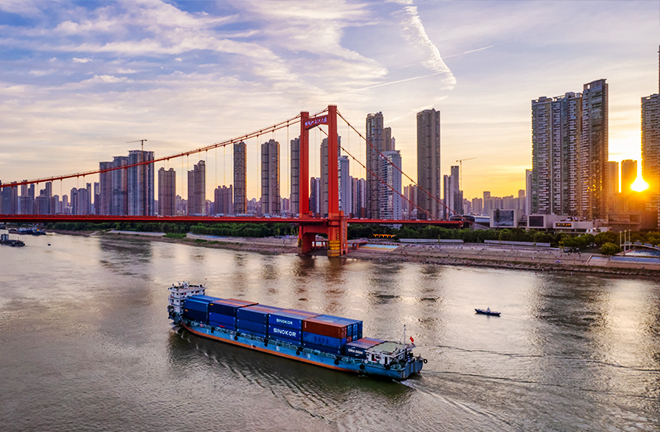Swedish scholar praises Chinese development model

A cargo ship sails on the Yangtze River in Wuhan, Hubei Province. Photo: TUCHONG
“The ability of the Chinese leadership, represented by the CPC, to manoeuvre a ship with now 1.4 billion people in both stormy seas and pleasant sunshine while keeping the same course of development which was designed 45 years ago is unprecedented in history,” said Hussein Askary, vice president of the Belt and Road Institute in Sweden, during a recent interview with CSST.
Askary attributed China’s unique development partly to its adoption of “peaceful means without aggression or wars of conquest of territories or wealth of other nations.” Moreover, throughout the past four decades, China has invested heavily in infrastructure and industrial supply chains, which are key elements of modern progress, as well as in human resources through education.
Pursuing independent innovation
To illustrate the distinctiveness of the Chinese development model, Askary referenced the construction of the “marvellous” high-speed rail system (HSR) in China, which was extended to 45,000 kilometres by the end of 2023.
The first HSR line, spanning just 160 kilometers between Beijing and Tianjin, was inaugurated in August 2008, coinciding with the onset of the global financial crisis in the United States. Comparing China and the West, Askary stated, “While in the West, governments poured trillions of dollars and euros into saving a bankrupt financial and banking system with no impact on the real economy and living standards, China invested massively in building infrastructure, education, and urbanization.”
To build the HSR, the Chinese government first established an “ecosystem” of universities and research organizations that worked with industries, Askary continued. In 2008, the Ministry of Science and Technology and the Ministry of Railways signed a cooperation agreement on a joint action plan for independent high-speed train innovation in China. This plan, according to a World Bank study published in 2018, brought together six massive companies, 25 universities, 11 scientific research institutes, 51 national laboratories and engineering centres, and a scientific and technological team composed of 68 academicians, 500 professors, and over 10,000 engineers and technicians.
“This collaboration allowed China to absorb, digest, and re-innovate foreign advanced technology in a short period of time to create a successful national product. Thus, China developed its own technological base for all kinds of rail-related equipment and engineering technologies,” Askary said.
Stressing another dimension of this “incredible” process, Askary said it enabled Chinese companies to become world champions in rail systems, rolling stock and trainsets, tunnelling and bridge building, and many other components that are now highly sought after worldwide. “Through the Belt and Road Initiative (BRI) launched in 2013, China has shared with many other nations its own achievements in this sector. This is a great lesson for all developing nations on how to turn a challenge into an opportunity and adapting foreign science and technology to national development plans,” he added.
Balancing regional development
Quoting the famous Chinese saying, “If you want to get rich, first build a road,” Askary highlighted the critical economic idea of the “development corridor.” The development corridor refers to a belt roughly 100-150 kilometre wide running alongside key infrastructure arteries, where new industrial, agricultural, and modern urban centres are established, he explained.
Taking the Yangtze River Economic Belt as an example, Askary noted that the belt, stretching along the Yangtze River of 6,300 kilometres, encompasses 11 provinces and municipalities and intersects with the BRI. The region is home to around 40% of the country’s population and accounts for over 40% of the national GDP.
“This economic belt strategy has had effects on all the interior regions of China. Now, we have such internationally known industrial hubs as Wuhan, Changsha, Chongqing, and Chengdu. And all the regions around them are highly developed and productive. All these new industrial centres became an integral part of the massive supply chain that has impact on the productivity not only of China, but even the world economy,” Askary observed.
Askary emphasized that achieving balanced economic development and reducing income disparities nationwide hinges on a key strategy known as the “Western Development Strategy.” Launched in 2000, this strategy aims to narrow the widening economic gap between affluent coastal eastern and southern regions and less developed western inland regions. Central to this strategy is the extensive development of infrastructure, particularly in energy and transport.
Askary noted that the Western Development Strategy was accelerated with the launch of the BRI, boosting economic development in western regions while enhancing connections to neighbouring countries. A major development in this regard was the establishment of the Western Region Land-Sea Corridor in 2019, which advanced the geographical advantage of cooperation with Southeast Asian and European countries. Thus, this strategy became integrated into the BRI.
“Rail development, specifically, took breath-taking leaps in this process. The 2,000-kilometre Qinghai-Tibet railway and the 1,900-kilometre Lanzhou-Xinjiang high-speed passenger railway are the longest and most spectacular projects of the strategy,” he asserted.
Askary pointed out that the net outcomes of this successful Western Development Strategy are multifaceted. “On the one hand, it lifted the western regions to higher living standard, eliminating poverty and inequality. On the other hand, it utilized the comparative advantages of these regions to establish new industrial and productive zones, contributing to the overall growth of the nation.”
Edited by CHEN MIRONG
